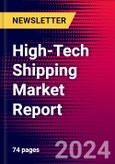High-tech is a fluid concept. In relation to shipbuilding, news outlets, industry associations, shipbuilders and other industry players apply the term according to their own perceptions. What may be a “high-tech ship” for some may for others not warrant the label. This report highlights and discusses companies whose products are truly at the technological cutting-edge in terms of technological complexity, novelty, efficiency, and/or compliancy. 'High-Tech Shipping Market Report' is a detailed 74-page report on the global high-tech shipping market. This report highlights and discusses the shipbuilders that have developed high-tech ships, notably within the last few years. It provides an up-to-date overview of the builders and their ships that stand at the forefront of technological development in the global shipbuilding industry. Based on research considering technical aspects of recent newbuilds, the report bypasses the PR-tainted approach of other publications, introducing a qualitative analysis of the companies and ships truly at the technological cutting-edge. Focusing on builders of commercial and private vessels, 18 leading companies and many more high-tech products are examined in detail. Key Findings: - Only a small number of the world’s shipbuilding companies can be classifed as engaging in high-tech shipping. And only a handful of countries can claim to have high-tech shipbuilding capacity. - Of the 18 leading shipbuilders examined in this report that produce high-tech ships, all of them are in OECD countries, with the highest concentration in Europe. - High-tech shipbuilding requires advanced supplier industries, heavy research and development spending, a highly skilled labour force, and other key conditions. Countries such as Germany and Norway are well advanced in these respects, with a correspondingly high concentration of high-tech shipbuilders relative to other nations. - China is among those nations pushing to break into high-tech shipbuilding, with leading Chinese shipbuilders close to producing some cutting-edge products. Cooperation with companies based in the OECD area are an important part of their development plans. - There is no direct correlation between the size of a high-tech shipbuilding company and how successful it is in developing new high-tech ship models. Very small companies can create a commanding position in niche markets. - Norway’s Ulstein Group is an example of a specialised shipbuilder, with fewer than 1,000 employees focused on constructing ships for the offshore industry; despite its size we identify three different high-tech ship models produced by Ulstein. - The resource advantage of larger companies does, however, mean that the best among them are able to produce cutting-edge ships across a broad range of ship types. - South Korea’s Daewoo Shipbuilding & Marine Engineering (DSME), one of the world’s three largest shipbuilders, with ships as varied as a platform installation/removal and pipe-laying vessel, Arctic LNG carriers, and (DSME-designed) LNG-powered container ships. - Central driving forces in high-tech shipbuilding include the growing importance of natural gas and renewables as global energy sources, increasingly strict global environmental regulations, the opening up of the Arctic as an area for resource exploitation, and the perennial demands of increased operational and energy ef ciency, safety, and performance. - High-tech ships represent all possible ship types and have a theoretically unlimited range of applications. - New types of LNG-powered ships, “smart” ships, innovative ice-breakers, and various other vessels will be among the high-tech shipbuilding industry’s response to these driving forces. - Deep sea mining and polar transit are emerging sectors likely to have signicant implications for high-tech shipbuilding.Of the 18 Leading Shipbuilders Examined in this Report that Produce High-Tech Ships, All of them Are in OECD Countries
Handbook of Container Shipping Management, Vol. 1
- Newsletter
- 239 Pages
- Global








